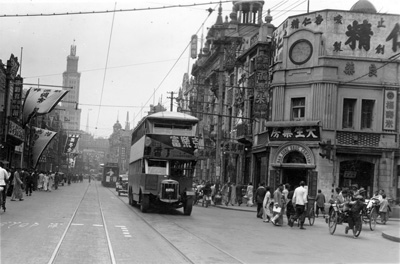A vanished Shanghai in black and white
An American opium trader stands beside his beloved horse in front of a Western-styled villa in Shanghai. The drug dealer is Francis Blackwell Forbes, one of the wealthiest US merchants in late 19th century China, who disguised his opium business by calling himself a "horse trader."
The photo portrait of Blackwell, the great grandfather of US Senator and former presidential candidate John Kerry is one of nearly 100 amazing photographs currently on exhibit at the Shanghai Art Museum.
|
Double-decker bus and the tramway on Nanjing road, taken in 1930s. [Global Times] |
Photographs taken from the mid-19th century to the 1950s reflect the dramatic changes in Shanghai since the days when it was acclaimed by Western traders as the "Paris of the East."
Shanghai was then a "paradise for adventurers," according to Taiwan-based Qin Feng, an avid collector of old photos whose collection accounts for more than half of the exhibit, including the photo of opium merchant Forbes.
"Forbes's luxury life was the envy of many of his contemporaries in his country, but he was just one among many during the influx of foreign adventurers," Qin said, adding that pictures such as this have great historical significance.
"This is the real image of Shanghai," he continued. "Hidden behind their luxurious life was the sadness, tears and sorrow of numerous poor Chinese families."
Another rare photo tells the same shameful history of foreign merchants getting rich on the backs of Shanghai laborers. The photo shows a cargo ship stacked high with trunks of opium in the shape of little black balls. Down-at-the-heel Chinese laborers, dressed in rags, are shown unloading the "goods".
Beginning in the 1840s, when the Qing court (1644-1911) was being defeated by Western countries, China was forced to open its gates to the West. Along with the influx of foreign traders came their most precious commodity – opium.
Shanghai was one of five ports first opened to the West under the Nanjing Treaty, signed three years after the first Opium War of 1840.
The bustling metropolis became the most active city where native culture was infused with Western lifestyles.
Pictures on display include a panoramic photograph of a splendid old building in the 1860s, the Shanghai Club for British Merchants, famous as the most exclusive club in Shanghai. Another old photo shows two rows of Western-style buildings standing on the banks of the Suzhou River which flows through the city.
All the photos tell the same story of an old Shanghai deeply influenced by Western culture.
 0 Comments
0 Comments








Comments